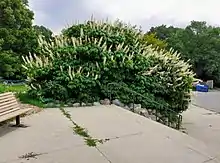Aesculus parviflora
Aesculus parviflora, the bottlebrush buckeye,[3] is a species of suckering deciduous shrub in the Sapindaceae family. The species is native to the southeastern United States, where it is found primarily in Alabama and Georgia, with a disjunct population in South Carolina along the Savannah River.[4][5] Its natural habitat is in mesic forests, on bluffs and in ravines.[4]
| Bottlebrush buckeye | |
|---|---|
 | |
| Scientific classification | |
| Kingdom: | Plantae |
| Clade: | Tracheophytes |
| Clade: | Angiosperms |
| Clade: | Eudicots |
| Clade: | Rosids |
| Order: | Sapindales |
| Family: | Sapindaceae |
| Genus: | Aesculus |
| Species: | A. parviflora |
| Binomial name | |
| Aesculus parviflora Walt. 1788 | |
 | |
| Generalized natural range | |
| Synonyms | |
|
Synonymy
| |
Description
Aesculus parviflora grows to 3–5 m tall. The leaves are arranged in opposite pairs, palmately compound with 5-7 leaflets, each leaflet short-stalked, 12–22 cm long and 5–10 cm broad, with an entire margin. The flowers are produced in conspicuous erect panicles 20–30 cm long resembling a traditional bottle brush, each flower with a tubular calyx, small white petals, and several protruding 3–4 cm long stamens.
The Latin specific epithet parviflora means "small-flowered".[6]
Cultivation and uses
Aesculus parviflora is grown as an ornamental plant in gardens, where its August flowering attracts butterflies. The naturalist, explorer and plant collector William Bartram first noted this undescribed shrub on his travels through Carolina, Georgia and Florida in 1773–78.[7] Though an old example was still to be found in Bartram's Garden, Philadelphia, in 1930,[8] the shrub has never become common in Eastern American gardens.
Aesculus parviflora was introduced to British horticulture through the activities of John Fraser, who made his first botanizing trip through the American South in 1785. Fraser's finds were distributed among English nurserymen like Lee and Kennedy or Loddiges or to private patrons, and the shrub was "to be met with in most of our nurseries" by 1820.[9] This plant has gained the Royal Horticultural Society's Award of Garden Merit.[10]
Gallery
 Habit (Aesculus parviflora)
Habit (Aesculus parviflora) Wild specimen showing typical growth form (Aesculus parviflora)
Wild specimen showing typical growth form (Aesculus parviflora).JPG.webp) Leaf nervature (Aesculus parviflora)
Leaf nervature (Aesculus parviflora).JPG.webp) Leaf nervature (Aesculus parviflora)
Leaf nervature (Aesculus parviflora).JPG.webp) Leaves (Aesculus parviflora)
Leaves (Aesculus parviflora)
References
- IUCN SSC Global Tree Specialist Group.; Botanic Gardens Conservation International (BGCI). (2020). "Aesculus parviflora". IUCN Red List of Threatened Species. 2020: e.T152911083A152911085. doi:10.2305/IUCN.UK.2020-1.RLTS.T152911083A152911085.en. Retrieved 3 May 2020.
- "Aesculus parviflora". NatureServe Explorer. NatureServe. Retrieved 2019-01-22.
- "Aesculus parviflora". Natural Resources Conservation Service PLANTS Database. USDA. Retrieved 22 January 2019.
- Alan Weakley (2015). "Flora of the Southern and Mid-Atlantic States".
- "Aesculus parviflora". County-level distribution map from the North American Plant Atlas (NAPA). Biota of North America Program (BONAP). 2014. Retrieved 22 January 2019.
- Harrison, Lorraine (2012). RHS Latin for gardeners. United Kingdom: Mitchell Beazley. p. 224. ISBN 9781845337315.
- Noted by Alice M. Coats, Garden Shrubs and Their Histories (1964) 1992, s.v. "Aesculus"; Bartram's botanizing explorations were recorded in his Travels through North and South Carolina, Georgia, East and West Florida, the Cherokee Country, etc., 1791.
- Coats 1992.
- Quoted in Coats 1992.
- "Aesculus parviflora". Royal Horticultural Society. Retrieved 10 March 2020.
External links
| Wikimedia Commons has media related to Aesculus parviflora. |
- Pink, A. (2004). Gardening for the Million. Project Gutenberg Literary Archive Foundation.
- Plants for a Future: Aesculus parviflora

